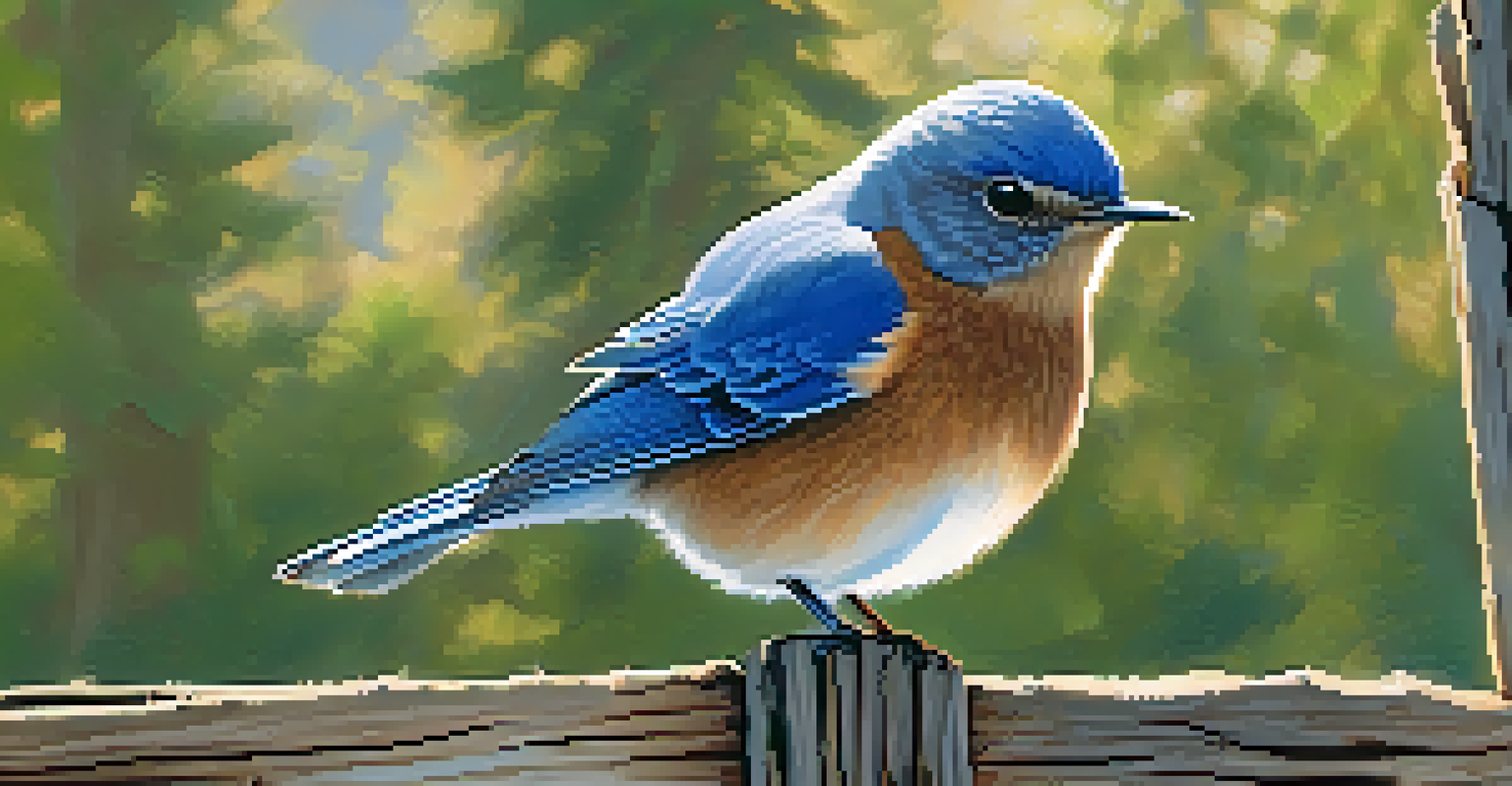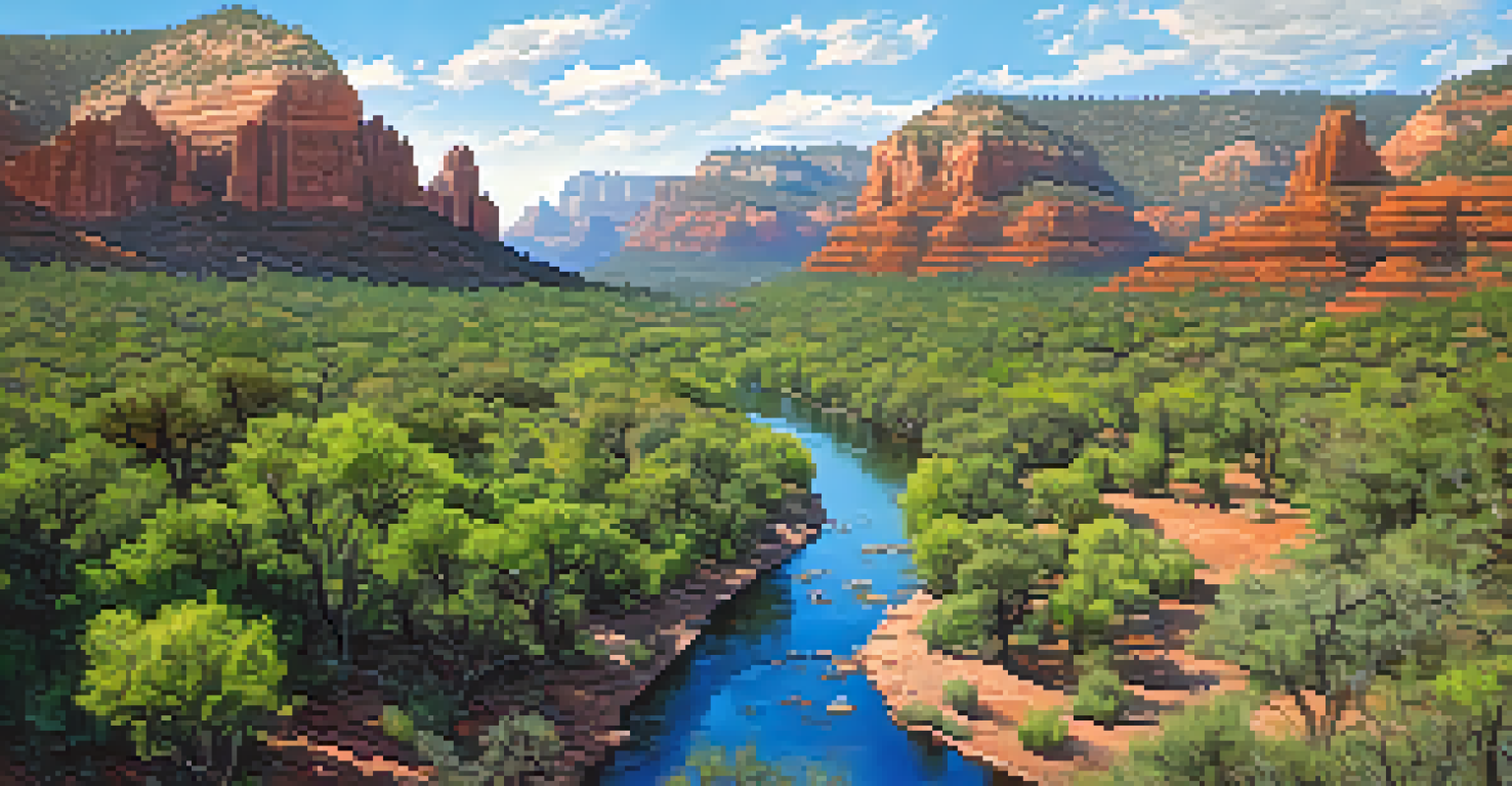Exploring Sedona's Unique Bird Species and Their Habitats

An Overview of Sedona's Birdwatching Scene
Sedona, Arizona, is not only famous for its stunning red rock formations but also for its rich avian diversity. Birdwatching enthusiasts flock to this picturesque region, drawn by the opportunity to spot a variety of species in their natural habitats. With over 400 bird species recorded, Sedona offers a birding experience that is both thrilling and accessible. Whether you are an expert ornithologist or a casual observer, the breathtaking scenery enhances the experience.
In every walk with nature one receives far more than he seeks.
The area's unique geography, including canyons, forests, and open skies, creates perfect conditions for many bird species. From the soaring hawks gliding above to the colorful hummingbirds flitting around the flowers, there's always something to see. Birdwatchers can explore various trails and parks, each offering a unique glimpse into the lives of these feathered inhabitants. The diverse ecosystems ensure that there’s never a dull moment for those with binoculars in hand.
For those looking to dive deeper, local birdwatching groups and guided tours provide valuable insights into the species you might encounter. This sense of community adds an extra layer of enjoyment, allowing you to share experiences and tips with fellow bird enthusiasts. Plus, learning about Sedona’s birds can spark a greater appreciation for wildlife conservation efforts in the area. The blend of camaraderie and nature makes every outing a memorable adventure.
Key Bird Species Found in Sedona
Sedona is home to a plethora of bird species, each with its own charm and significance. Among the most notable is the American Robin, known for its cheerful song and bright orange breast. This familiar sight can often be spotted hopping around parks and gardens, heralding the arrival of spring. The presence of robins is a reminder of the cyclical beauty of nature, making them a beloved bird for many locals and visitors alike.

Another spectacular bird to look out for is the Western Bluebird, with its vibrant blue plumage and melodious call. These birds thrive in open woodlands and are often seen perched on fence posts or darting through fields in search of insects. Their striking colors can brighten any landscape, making them a favorite among photographers and birdwatchers alike. Observing their behavior adds another layer of enjoyment to your birdwatching experience.
Diverse Bird Species in Sedona
Sedona is home to over 400 bird species, offering birdwatchers a thrilling experience amid stunning landscapes.
Don’t forget to keep an eye out for the majestic Red-tailed Hawk, a common sight soaring high above the red rocks. These raptors are known for their keen eyesight and powerful hunting skills, often swooping down to catch their prey. Watching them glide effortlessly against the backdrop of Sedona’s stunning landscape can be a breathtaking experience. Each bird species contributes to the rich tapestry of life in Sedona, making every outing a chance for discovery.
The Importance of Bird Habitats in Sedona
Understanding the habitats that support Sedona's diverse bird species is crucial for their conservation. From oak woodlands to riparian zones along rivers, these habitats provide food, shelter, and nesting sites for various birds. Healthy ecosystems ensure a balance that benefits both wildlife and human communities. By exploring these habitats, birdwatchers can gain a deeper appreciation for the intricate relationships that sustain local avian populations.
The clearest way into the Universe is through a forest wilderness.
Sedona's varied terrain creates distinct microhabitats that cater to different bird species. For instance, the lush greenery near Oak Creek attracts a variety of songbirds, while the arid desert areas are home to species adapted to drier conditions. Each habitat plays a vital role in the life cycle of birds, influencing their behavior and migration patterns. Understanding these dynamics can enhance your birdwatching experience, as you learn to recognize where specific species are likely to be found.
Moreover, preserving these vital habitats is essential for maintaining Sedona's ecological balance. Local conservation efforts aim to protect these areas from development and pollution, ensuring that birds continue to thrive. By participating in birdwatching, you become an advocate for these habitats, fostering a greater connection with nature. Every bird sighting is a reminder of the importance of protecting the environment for future generations.
Best Times for Birdwatching in Sedona
Timing can significantly enhance your birdwatching experience in Sedona. The early morning hours are often considered the best time to catch birds in action as they are most active during dawn. The quiet of the morning allows you to hear their songs and calls more clearly, making it easier to spot them. With the sun rising over the red rocks, the experience is not only rewarding but also visually stunning.
Spring is another prime season for birdwatching, as many migratory species return to Sedona during this time. The warmer weather leads to increased activity, with birds searching for mates and nesting sites. This vibrant time of year attracts birders eager to witness the arrival of new species and the return of familiar faces. Observing the courtship rituals and nesting behaviors adds an exciting dimension to your birdwatching adventures.
Importance of Bird Habitats
Understanding and preserving Sedona's unique habitats is crucial for the survival of its diverse avian populations.
However, each season offers unique birdwatching opportunities. In the fall, for instance, you might witness migration as birds travel south for the winter. Winter can also bring unique visitors, such as the American Tree Sparrow, that might not be seen during other months. By understanding the seasonal patterns, you can plan your visits to maximize your chances of encountering a diverse range of bird species.
Popular Birdwatching Locations in Sedona
Sedona boasts several prime locations for birdwatching, each offering unique environments and species to discover. One of the most popular spots is Red Rock State Park, where lush riparian habitats meet breathtaking red rock formations. The park provides excellent trails and viewing areas, making it easy to spot various birds while enjoying the stunning scenery. Birdwatchers often gather here, creating a vibrant community atmosphere.
Another fantastic location is the Oak Creek Canyon, where the cool, moist air supports diverse wildlife. The canyon's dense vegetation attracts many songbirds, and the sound of their melodic calls fills the air. Hiking along the creek offers opportunities to see birds perched in the trees or flitting about. The serene environment also provides a perfect backdrop for reflection and relaxation during your birdwatching adventures.
Lastly, the Munds Mountain Wilderness offers a more rugged experience, with its higher elevation and varied terrain. Here, you might encounter raptors soaring overhead or hear the calls of elusive forest birds. The wilderness setting provides a sense of solitude, allowing you to connect with nature on a deeper level. Exploring these diverse locations can deepen your appreciation for Sedona's avian life and its stunning landscapes.
Tips for Successful Birdwatching in Sedona
To make the most of your birdwatching experience in Sedona, preparation is key. Start by bringing along essential gear such as binoculars, a field guide, and a notebook to record your sightings. A good pair of binoculars can make all the difference, allowing you to observe birds up close without disturbing them. Taking notes helps track your progress and enhances your learning experience as you identify different species.
It's also important to respect the natural environment while birdwatching. Maintain a safe distance from nesting sites and avoid disturbing wildlife. Using quiet movements and soft voices can help prevent scaring birds away. Remember, the goal is to observe without intruding on their natural behaviors. Practicing patience and mindfulness will yield the best results for both you and the birds.
Best Times for Birdwatching
Early mornings and spring seasons are ideal for birdwatching in Sedona, as many species are most active during these times.
Lastly, consider joining local birdwatching groups or clubs to enhance your experience. These communities often host events, workshops, and guided tours that can provide valuable insights and camaraderie. Learning from experienced birders can deepen your understanding and appreciation of Sedona's birdlife. Whether you're a seasoned expert or a curious beginner, connecting with others can enrich your birdwatching journey.
The Role of Conservation in Protecting Bird Species
As birdwatchers and nature enthusiasts, understanding the importance of conservation is crucial for protecting Sedona's unique bird species. Habitat destruction, climate change, and pollution pose significant threats to avian populations. By raising awareness and participating in conservation efforts, you can help safeguard the ecosystems that support these birds. Every small action counts, whether it’s supporting local conservation initiatives or educating others about the importance of protecting wildlife.
Many organizations work tirelessly to preserve Sedona’s natural habitats, ensuring that birds have safe spaces to thrive. Volunteering for local clean-up events or habitat restoration projects can be a rewarding way to give back. Additionally, participating in citizen science projects can contribute valuable data for researchers studying bird populations and their behaviors. Engaging with these efforts fosters a sense of community and shared responsibility for the environment.

Ultimately, the beauty of birdwatching extends beyond mere observation; it’s about fostering a deeper connection with nature and understanding our role in protecting it. As you explore Sedona's avian diversity, let the experience inspire you to advocate for conservation. Together, we can ensure that future generations will also have the opportunity to witness the remarkable bird species that call Sedona home.